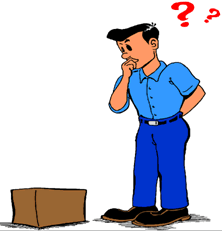- Small children should never carve pumpkins. Children can draw a face with markers. Then parents can do the cutting.
- Consider using a flashlight or glow stick instead of a candle to light your pumpkin. If you do use a candle, a votive candle is safest.
- Candlelit pumpkins should be placed on a sturdy table, away from curtains and other flammable objects, and should never be left unattended.
Month: October 2013
Learning From a Near Miss or Close Call
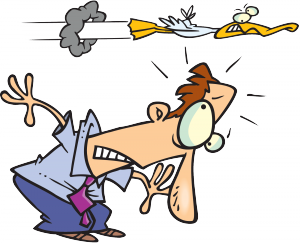 A near miss is an unplanned event that did not result in injury, illness, or damage – but had the potential to do so. Only a fortunate break in the chain of events prevented an injury, fatality or damage; in other words, a miss that was nonetheless very near. Although the label of ‘human error’ is commonly applied to an initiating event, a faulty process or system invariably permits or compounds the harm, and should be the focus of improvement. Other familiar terms for these events is a “close call”, or in the case of moving objects, “near collision” or a near hit.
A near miss is an unplanned event that did not result in injury, illness, or damage – but had the potential to do so. Only a fortunate break in the chain of events prevented an injury, fatality or damage; in other words, a miss that was nonetheless very near. Although the label of ‘human error’ is commonly applied to an initiating event, a faulty process or system invariably permits or compounds the harm, and should be the focus of improvement. Other familiar terms for these events is a “close call”, or in the case of moving objects, “near collision” or a near hit.
Keep Children Safe On-line
 Almost all children today have access to the Internet through schools, libraries, community centers, or their home. And most 8 to 18-year-olds, 74 percent, have Internet access from their home computers according to the Kaiser Family Foundation.
Almost all children today have access to the Internet through schools, libraries, community centers, or their home. And most 8 to 18-year-olds, 74 percent, have Internet access from their home computers according to the Kaiser Family Foundation.
Not only do more children have access to the Internet than ever before, but they are using it more, too. Many schools incorporate the Internet into their curricula and encourage online research for projects. But that’s not all kids are doing online. They also email, chat with friends through instant messenger and in chat rooms, play games, create websites and web blogs, and just surf the ‘net.
Even as kids grow savvier in their use of the Internet, it can still be a dangerous place. The good news is that most dangers can be avoided if children and their parents learn about smart Internet use.
Eye Safety
 Each day about 2000 U.S. workers have a job-related eye injury that requires medical treatment. About one third of the injuries are treated in hospital emergency departments and more than 100 of these injuries result in one or more days of lost work. The majority of these injuries result from small particles or objects striking or abrading the eye. Examples include metal slivers, wood chips, dust, and cement chips that are ejected by tools, wind blown, or fall from above a worker. Some of these objects, such as nails, staples, or slivers of wood or metal penetrate the eyeball and result in a permanent loss of vision. Large objects may also strike the eye/face, or a worker may run into an object causing blunt force trauma to the eyeball or eye socket. Chemical burns to one or both eyes from splashes of industrial chemicals or cleaning products are common. Thermal burns to the eye occur as well. Among welders, their assistants, and nearby workers, UV radiation burns (welder’s flash) routinely damage workers’ eyes and surrounding tissue.
Each day about 2000 U.S. workers have a job-related eye injury that requires medical treatment. About one third of the injuries are treated in hospital emergency departments and more than 100 of these injuries result in one or more days of lost work. The majority of these injuries result from small particles or objects striking or abrading the eye. Examples include metal slivers, wood chips, dust, and cement chips that are ejected by tools, wind blown, or fall from above a worker. Some of these objects, such as nails, staples, or slivers of wood or metal penetrate the eyeball and result in a permanent loss of vision. Large objects may also strike the eye/face, or a worker may run into an object causing blunt force trauma to the eyeball or eye socket. Chemical burns to one or both eyes from splashes of industrial chemicals or cleaning products are common. Thermal burns to the eye occur as well. Among welders, their assistants, and nearby workers, UV radiation burns (welder’s flash) routinely damage workers’ eyes and surrounding tissue.
via CDC – Eye Safety – NIOSH Workplace Safety and Health Topic.
Autumn Driving Safety Tips
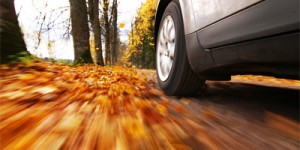 Make adjustments for the light. Did you know that we lose a minute of daylight every day until the clocks are set back in November? Fewer hours of daylight make it more difficult to see pedestrians, cyclists and children playing in the late afternoon. Also, later sunrises mean that drivers need to adjust to the brighter sun at different times of the morning. Always keep a pair of sunglasses in your car to shield your vision.
Make adjustments for the light. Did you know that we lose a minute of daylight every day until the clocks are set back in November? Fewer hours of daylight make it more difficult to see pedestrians, cyclists and children playing in the late afternoon. Also, later sunrises mean that drivers need to adjust to the brighter sun at different times of the morning. Always keep a pair of sunglasses in your car to shield your vision.- Avoid driving over wet leaves. Fall foliage is beautiful but once those leaves start falling and get wet from rain, they can become a serious driving hazard. Wet leaves are slippery and reduce traction.
- Don’t Veer for Deer. If a crash with a deer is unavoidable, remember don’t swerve. Be sure to brake firmly and hold onto the steering wheel with both hands. Come to a controlled stop and move the vehicle out of traffic to a safe location.
- Prepare an emergency kit for your car. Carrying an emergency kit in your car trunk or cargo area can be a real lifesaver. Be sure to include a flashlight, flares and a first-aid kit, jumper cables, extra washer fluid, nonperishable food, a jug of water, and a few basic tools such as wrenches, a ratchet/socket set, screwdrivers, and pliers.
- Watch for frost. Low nighttime temperatures cause frost on windshields and roads. Be sure to clear your windshield completely before driving. Also, slow down when approaching bridges and overpasses, as these structures are more prone to collect frost on the roadway surface. Stay alert for shaded areas that could create black ice during early morning and evening hours.
- Plan ahead for changing weather conditions. Have your car winterized before the winter storm season sets in. Keeping your car in good condition decreases your chance of being stranded in cold weather. Also, be sure to have a first-aid kit, thermal blanket, a working flashlight, a shovel and sand in your car.
- Watch for construction work zones. Construction work zones may still be active. Consult MDOT’s Mi Drive traffic Web site to plan your route. Please remember to slow down and pay attention in work zones. The life you save could be your own.
Work-related Health Challenges Facing Women
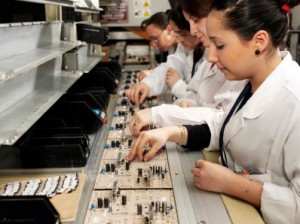 Women face different workplace health challenges than men. This is partly because men and women tend to have different kinds of jobs. Women generally have more work-related cases of carpal tunnel syndrome, tendonitis, respiratory diseases, infectious and parasitic diseases, and anxiety and stress disorders. Social, economic, and cultural factors also put women at risk for injury and illness. For example, women are more likely than men to do contingent work part-time, temporary, or contract work. Compared to workers in traditional job arrangements, contingent workers have lower incomes and fewer benefits. Like all workers in insecure jobs, women may fear that bringing up a safety issue could result in job loss or more difficult work situations. They may also be less likely to report a work-related injury.
Women face different workplace health challenges than men. This is partly because men and women tend to have different kinds of jobs. Women generally have more work-related cases of carpal tunnel syndrome, tendonitis, respiratory diseases, infectious and parasitic diseases, and anxiety and stress disorders. Social, economic, and cultural factors also put women at risk for injury and illness. For example, women are more likely than men to do contingent work part-time, temporary, or contract work. Compared to workers in traditional job arrangements, contingent workers have lower incomes and fewer benefits. Like all workers in insecure jobs, women may fear that bringing up a safety issue could result in job loss or more difficult work situations. They may also be less likely to report a work-related injury.
via CDC – Women’s Safety and Health Issues at Work – NIOSH Workplace Safety and Health Topic.
Keep Your Kids Safe From Firearms
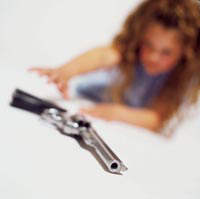 We need to take extra precautions when kids are in an environment where guns are present.
We need to take extra precautions when kids are in an environment where guns are present.
The Hard Facts
It is estimated that about one third of households with childrens ages 17 and under have a gun in the home.
Top Tips
- Store firearms in a locked location, unloaded, out of the reach and sight of children.
- Store ammunition in a separate locked location, out of the reach and sight of children.
- Keep the keys and combinations hidden.
- When a gun is not in its lock box, keep it in your line of sight.
- Make sure all firearms are equipped with effective, child-resistant gun locks.
Opioid Abuse
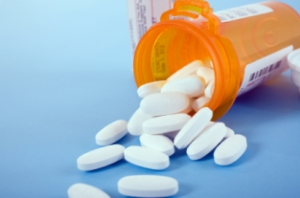 Opioids are powerful pain killers that are highly addictive. Opioid dependence affects nearly 5 million people in the United States and leads to approximately 17,000 deaths annually.
Opioids are powerful pain killers that are highly addictive. Opioid dependence affects nearly 5 million people in the United States and leads to approximately 17,000 deaths annually.
via Opioid Abuse.
Back Injury Prevention
DO…
- Plant your feet firmly – get a stable base.
- Bend at your knees – not your waist.
- Tighten your abdominal muscles to support your spine.
- Get a good grip – use both hands.
- Keep the load close to your body.
- Use your leg muscles as you lift.
- Keep your back upright, keep it in its natural posture.
- Lift steadily and smoothly without jerking.
- Breathe – If you must hold your breath to lift it, it is too heavy – GET HELP.
DO NOT…
- Lift from the floor.
- Twist and lift.
- Lift with one hand (unbalanced)
- Lift loads across obstacles.
- Lift while reaching or stretching.
- Lift from an uncomfortable posture.
- Don’t fight to recover a dropped object.
- Don’t hold your breath while lifting.
First-aid Kits
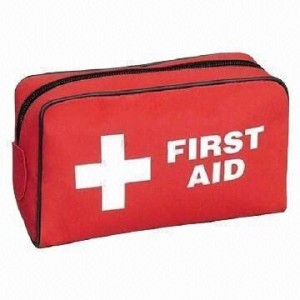 A well-stocked first-aid kit can help you respond effectively to common injuries and emergencies. Keep at least one first-aid kit in your home and one in your car. Store your kits in easy-to-retrieve locations that are out of the reach of young children. Children old enough to understand the purpose of the kits should know where they are stored.
A well-stocked first-aid kit can help you respond effectively to common injuries and emergencies. Keep at least one first-aid kit in your home and one in your car. Store your kits in easy-to-retrieve locations that are out of the reach of young children. Children old enough to understand the purpose of the kits should know where they are stored.
via First-aid kits: Stock supplies that can save lives – MayoClinic.com.


